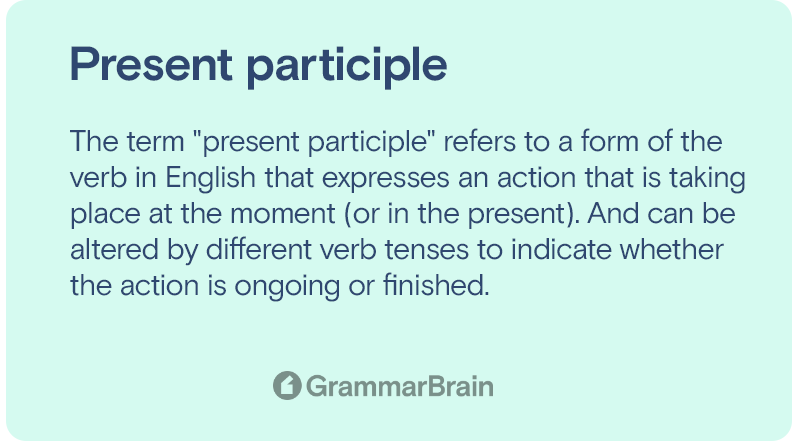What is a present participle? How is it it used in English? How are they formed? And what are the grammar rules that govern them? These are all common questions that will get answered in this complete English grammar guide. Continue reading to start learning!

What is the present participle?
The term “present participle” refers to a form of the verb in English that expresses an action that is taking place at the moment (or in the present). And can be altered by different verb tenses to indicate whether the action is ongoing or finished. A noun phrase.
Adjective phrases, nouns, or adjectives can all be modified by the verb. Additionally, a present participle can be used in four different verb tenses (as seen below) and employed as an adjective to modify another noun or adjective.
Present participle used as an adjective
The present participle can also be coupled with the adjectives, as shown below. Because a participle can function as an adjective, it can also produce an adjective phrase, or “participial phrase,” in this instance. Participial phrases, like other adjective phrases, are collections of words that begin with a participle and serve to characterize a noun.
- It was an alluring scene.
- The game was satisfying.
- We checked the horrifying notes.

Present Participle With Verb Tenses
By altering the present participle with various verb tenses, including the present progressive, simple present tense, present perfect, and present perfect progressive tense, it is possible to demonstrate various points in the timeline.
Simple Present Tense
The simple present tense indicates something is happening in the story’s current context. This present participle is the same as the present tense of the verb without any additional modifiers or helper verbs (e.g., talk).
Example sentences:
- I can talk for the whole day with my best friend.
- When I am bored with my studies, I like to write poems from my imagination.
- I am going to study as my semester exams are coming at the end of this week.
Present Perfect Tense
The present perfect tense demonstrates that an action began in the past and is still in progress now. The present participle in this form complements the present tense of the verb “have” (e.g., have talked).
Example sentences:
Present Continuous Tense
The present progressive tense depicts some continuing or ongoing activity that is happening right now but hasn’t necessarily finished. This present participle matches the present tense of the verb “to be” and ends in -ing rather than -ed (e.g., am talking).
Example sentences:
- I am currently studying for my exams.
- My dog is eating the food, after which he will go for a walk.
- I am dancing in the hall.
Present Perfect Continuous Tense
The present perfect progressive tense depicts an ongoing activity that started in the past, was finished, but is still relevant in the present. When used with the present passive form of the verb had, this present participle form ends in -ing rather than -ed and might represent a duration for the activity (e.g., have been talking for three hours).
- I have been eating for 2 hours.
- She has been crying for the last two hours.

Making Present Participle
Normal Verbs
Regarding the present participle, two tenses (present progressive & present perfect progressive) end most frequently in -ing. One (present perfect) ends in -ed, and one form is highly similar to the infinitive (simple present).
Regular verbs form the “generic” case for the present participle, & most verbs are expected to adhere to the straightforward guidelines mentioned above.
Irregular Verbs
Regular verb usage does have certain exceptions, which we refer to as “irregular,” like with most English grammar. This is the problematic element of the language that must be learned by heart for various nouns, adjectives, and verbs. The list of frequent irregular verbs and their present participle forms is provided below.
Example:
- Present: Talk
- Present participle: I talk/I am talking/I have talked
- Present: bite
- Present participle: I bite/I am biting/I have bitten
It becomes apparent from the examples in the preceding section that the present participle is a grammatical construction that is quite widespread, whether or not one is aware of its name.
The majority of the time, it is said or written correctly, but irregular verbs are the ones that tend to cause the most confusion. The present participle is easier to think about than the past or future participles because there are fewer variations of irregular verbs to remember. And one may be sure that even more irregular verbs fall under the general category.
Present participle vs. Gerunds
While both can look similar, a gerund will only act as a noun. In contrast, the present participle acts as an adjective or verb. When you add ‘ing’ to a verb, it becomes a gerund.
You can add excitement and information to your sentences by using participle phrases. Any additional modifiers you may offer are beneficial since readers like to know more about what is happening in a sentence.
However, be careful where you place those participle words, and make sure they aren’t left hanging as modifiers!
FAQs
What is an example of a present participle?
What is the present participle’s grammar rule?
Adding the suffix -ing to the root form creates the present participle for most verbs. For instance, exhibiting is the present participle of the verb ‘exhibit.’
What distinguishes the present tense from the present participle?
The verb’s present participle is one of its forms, namely its -ing form. A verb tense is present continuous (also known as progressive). The present continuous tense is created by combining the present participle with the corresponding form of to be. ‘Reading’ is the present participle of the verb “read.”
Why are present participles used?
A present participle can express one of two simultaneous activities that the same thing or person carries out. The initial action might be expressed with a present participle when it occurs rapidly after another action performed by the same person or thing.
Can a present participle be used to begin a sentence?
In most cases, the present-participial phrase serves as an adjective. It may appear at any point in a sentence—at the start, middle, or conclusion. Make sure the grammatical subject of the sentence is the one carrying out the verbal activity when you begin a sentence with a present-participial phrase.
What kinds of participles are there?
Present participles & past participles are the two categories of participles. The perfect tenses are expressed using the past participle, while the continuous tenses are expressed using the present participle. Both are adverbial terms.
Inside this article
Fact checked:
Content is rigorously reviewed by a team of qualified and experienced fact checkers. Fact checkers review articles for factual accuracy, relevance, and timeliness. Learn more.
Core lessons
Glossary
- Abstract Noun
- Accusative Case
- Anecdote
- Antonym
- Active Sentence
- Adverb
- Adjective
- Allegory
- Alliteration
- Adjective Clause
- Adjective Phrase
- Ampersand
- Anastrophe
- Adverbial Clause
- Appositive Phrase
- Clause
- Compound Adjective
- Complex Sentence
- Compound Words
- Compound Predicate
- Common Noun
- Comparative Adjective
- Comparative and Superlative
- Compound Noun
- Compound Subject
- Compound Sentence
- Copular Verb
- Collective Noun
- Colloquialism
- Conciseness
- Consonance
- Conditional
- Concrete Noun
- Conjunction
- Conjugation
- Conditional Sentence
- Comma Splice
- Correlative Conjunction
- Coordinating Conjunction
- Coordinate Adjective
- Cumulative Adjective
- Dative Case
- Determiner
- Declarative Sentence
- Declarative Statement
- Direct Object Pronoun
- Direct Object
- Diction
- Diphthong
- Dangling Modifier
- Demonstrative Pronoun
- Demonstrative Adjective
- Direct Characterization
- Definite Article
- Doublespeak
- False Dilemma Fallacy
- Future Perfect Progressive
- Future Simple
- Future Perfect Continuous
- Future Perfect
- First Conditional
- Irregular Adjective
- Irregular Verb
- Imperative Sentence
- Indefinite Article
- Intransitive Verb
- Introductory Phrase
- Indefinite Pronoun
- Indirect Characterization
- Interrogative Sentence
- Intensive Pronoun
- Inanimate Object
- Indefinite Tense
- Infinitive Phrase
- Interjection
- Intensifier
- Infinitive
- Indicative Mood
- Participle
- Parallelism
- Prepositional Phrase
- Past Simple Tense
- Past Continuous Tense
- Past Perfect Tense
- Past Progressive Tense
- Present Simple Tense
- Present Perfect Tense
- Personal Pronoun
- Personification
- Persuasive Writing
- Parallel Structure
- Phrasal Verb
- Predicate Adjective
- Predicate Nominative
- Phonetic Language
- Plural Noun
- Punctuation
- Punctuation Marks
- Preposition
- Preposition of Place
- Parts of Speech
- Possessive Adjective
- Possessive Determiner
- Possessive Case
- Possessive Noun
- Proper Adjective
- Proper Noun
- Present Participle
- Prefix
- Predicate



